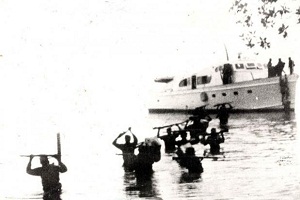 Where the expeditionaries landed, the sea was shallow and calm. Three men jumped from the boat. Juan Almeida observed, “At first the water reached their waists, then their chests, their chins … then again, below their necks, their chests. With the rope in their hands, they reached the mangroves and tied it off. Now they jump in, one at a time. The heavier men sink into the mud when they jump, the lighter ones help them out.”
Where the expeditionaries landed, the sea was shallow and calm. Three men jumped from the boat. Juan Almeida observed, “At first the water reached their waists, then their chests, their chins … then again, below their necks, their chests. With the rope in their hands, they reached the mangroves and tied it off. Now they jump in, one at a time. The heavier men sink into the mud when they jump, the lighter ones help them out.”
The mangroves form a tangled labyrinth and hide the shore, extending two kilometers inland. The revolutionaries stumble on the roots, fall. Their boots crack. Thorny trees and sharp edges tear their uniforms. Their weapons and backpacks are wet, valuable ammunition immersed.
They were delayed hours in the swamp. Years later, Che recalled the landing, “We were on firm ground, disoriented, stumbling, an army of shadows, of ghosts, walking as if guided by some psychological impulse.”
Seven days earlier, November 25, 1956, around 2:00am, they had departed from the Mexican port of Tuxpan, in the yacht Granma. The crossing to Cuba was plagued by rough seas, the overload, and both motors inoperative for more than 48 hours.
During the dawn hours December 2, the boat hit bottom at a site known as Los Cayuelos, about two kilometers from Las Coloradas beach, northeast of Cabo Cruz. After the slow paced march, interrupted by falls, fatigue and rest stops, the troops reached El Mijial on the 3rd, and the Varón Vega family prepared some chicken and cassava for them, soup for the weakest, and honey.
The march continued. In Agua Fina (December 4), they were again fed by campesinos, and during the night, by then the 5th, they reached Alegría de Pío. According to Che, “It was a small key covered with scrub, with a cane field on one side, and open to some coves on the other, with thick woods beginning farther away.”
Many took their boots off and put their socks in the sun to dry.
The doctors Faustino Pérez and Che began to dress the bleeding blisters. Later Ramiro Valdés handed out crackers and pieces of sausage. Almeida looked at his watch; it was 4:20 pm. Just 20 minutes later, the first shots rang out and the gunfire began.
The captain of the dictatorship’s troops called for surrender. Almeida responded as he fired, “No one here is surrendering,” and said to Che, “Put something on your neck, you’re really bleeding, let’s get out of here.”
Only three expeditionaries were not able to escape: Humberto Lamothe, Oscar Rodríguez and Israel Cabrera, the first martyrs. The rest of the rebels scattered.
Still firing, Fidel continued to give orders, and along with Juan Manuel Márquez and Universo Sánchez moved east into the field. Moving along in short stretches one at a time, Juan Manuel is lost. They return to look for him, and instead find Faustino Pérez. In the darkness of night, they hide in the scrub.
In the meantime, Raúl forms a group with Ciro Redondo, Efigenio Ameijeiras, René Rodríguez, Armando Rodríguez and César Gómez, while Almeida manages to pull together Che, Ramiro, Reynaldo Benítez and Rafael Chao.
Writing later about the struggles of this last group, Che said, “We walked until the night prevented us from advancing, and resolved to sleep together, in a pile, attacked by mosquitoes, gripped by hunger and thirst… This was our baptism by fire… this is how the Rebel Army would begin to be forged.”
(By Pedro Antonio García, diario Granma)